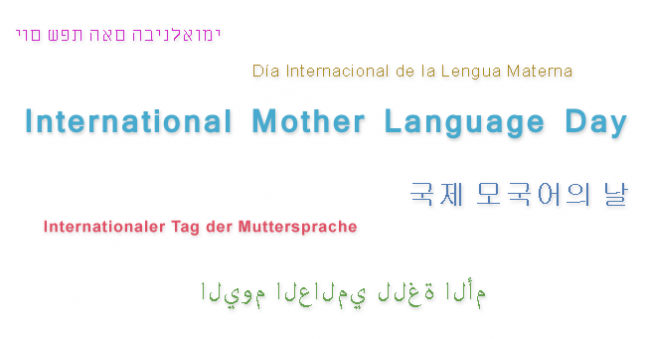With every language that dies out, a picture of humanity is extinguished.
Octavio Paz (1914 – 1998)
On February 21, the UNESCO will be celebrating the 14th annual International Mother Language Day this year. It is dedicated to all endangered languages and their speakers. At the same time it is also meant to commemorate four students that lost their lives in the fight for their mother language. Here you will learn what is behind all this and what it has to do with the languages of the world.
Background
After colonized British India was divided into Pakistan and India in 1947, the situation was bleak for Pakistan. Separated by India, East and West Pakistan differed culturally and linguistically to such an extent that the two were really only united as one on paper. When the Pakistani government declared Urdu as the sole official language in 1948, even though it was spoken by less than 3% of the population of East Pakistan, the situation became increasingly dire. That’s how it came to pass that on February 21, 1952, students staged a public demonstration for their native language in front of the University of Dhaka. Their protest was to come to an abrupt end when the police fired indiscriminately into the crowd, justified by the ban on demonstrations. Four young people died in the fight for the right to speak their mother language. Ever since, all of Bangladesh (formerly East Pakistan) has observed this „Day of the Martyr“ as a day of commemoration.
As a result of a letter sent to UNESCO by Rafiqul Islam, February 21, 2000 became the first time that the four dead students and all endangered languages of the world were memorialized internationally.

The Linguapax Award
Starting in 2002, the UNESCO Linguapax Institute in Barcelona has also awarded the Linguapax Award each year on the International Mother Language Day. It recognizes people who campaign for the preservation of linguistic diversity, multilingualism, as well as the reactivation and revitalization of various language communities.
Previous winners include Neville Alexander (2008), a fellow campaigner with Nelson Mandela, and the Mauritius-based association Ledikasyon pu Travayer (2013).
The Extinction of Languages and Their Preservation
The true importance of International Mother Language Day becomes apparent when you consider that a language dies just every two weeks. If nothing is done to stop this, only about 3500 of the current 6000 known languages of the world would be left by the end of the 21st century. Languages with fewer than 1000 speakers – so about 27% of all languages worldwide – are the hardest hit.
Why Languages Die Out
Although there are a few reasons for the extinction of languages.So olonizing countries and religious groups threaten entire ethnic groups and their languages by invading their regions, discriminating against the natives, forcing them to assimilate, or deporting them if necessary. One example of this is the colonization of South America by Portugal and Spain.
How Endangered Languages Can Survive
If speakers of the endangered language openly speak and continue to teach it, then the language can be saved. Nonetheless, political dedication, financial resources, and an end to discrimination against linguistic minorities are equally indispensable in order to ensure the continued preservation of a language.
For example in Europe it has been shown that granting regional and cultural autonomy, raising children bilingually, and cultivating public support programs are effective measures for preventing the extinction of ethnic groups and thus also protecting their language from extinction.
Dying Languages
All the same, the number of endangered languages is great, This means that severely endangered languages are the rule on every one of our continents. A few examples…
Africa
About 2100 of the known languages of the world call Africa home, 350 of them are severely endangered.
Ever since the Arabic colonization of North Africa in the 7th century, the Berber languages were among the many that were displaced. The situation was especially grave in Algeria where around 25% of the population still speaks one of the endangered languages. All the same, the government continues to thwart every attempt made by the Berbers to save their languages.
The Sans’ click language in South Africa is in even more dire straits. Although they are one of the oldest peoples of the world, they are displaced and oppressed even today so that barely more than 100,000 of them remain. Members of the San who remain usually cannot read or write, work on farms, and have no say in political matters. One of their most endangered languages is Xiri, which fewer than 90 people still speak.
Asia
Asia is the most language-rich continent on our planet. Yet 1000 of the languages there are threatened with extinction, of them scarcely 200 are in India and 150 in Indonesia.
Ainu, the language of the indigenous Japanese, is one of them. Fewer than 15 people still possess a command of the language. The Japanese Goverment caused this when it declared the indigenous peoples of Hokkaido as fellow countrymen in 1869, forced them into assistance services, and outlawed their mother tongue.
But even a language that is still actively spoken by more than 6 million people can be an endangered language. Tibetan, whose survival is seriously threated by the encroachment of Mandarin, is an example of this. Without Mandarin no Tibetan has a chance to work.
Australia
Up until the end of the 18th century, there were over 800 different indigenous languages on the Australian continent. In the 21st century no more than 150 of them remain. One of the factors to blame for this was the language politics of Australia, which tried to destroy the entire language of the aborigines. In order to right these wrongs, appropriate efforts are now being made by the government to protect the remaining indigenous cultures and languages of Australia.
Despite these efforts, many languages are still seriously endangered. This includes the language Yanyuwa, which is still spoken by no more than ten people. We have anthropologist John Bradley to thank that the language is preserved on paper at least, since he wrote a dictionary and grammar of it.
North America
There is also a multitude of seriously endangered languages in North America. Between 1997 and 2009 more than 20 died out there. The government is now trying to slow this negative trend by means of the Esther Martinez Native American Languages Preservation Act.
Hawaiian is one of the endangered languages in the United States. It is indeed one of the official languages of Hawaii in addition to English, but is only spoken by around 1000 of the 140,000 members.
Additionally, the Skarure language of the Tuscarora people is nearly extinct. Of the scarcely 1000 Tuscarora, who live mainly on their reservations in the state of New York or Ontario, only about ten still speak their native language. With the help of the Language Revitalisation Program, Skarure is, however, now being taught in schools. So it has a chance to survive..
South America
Since colonization by Portugal and Spain in the 15th and 16th centuries, the languages of Central and South America’s indigenous peoples have been in dire straits.
Itza’ Maya, an old Mayan language spoken in Guatemala, is currently one of the severely endangered languages. Of the 2000 members of the Itza’ Maya People, maybe about 5 speak it fluently and another 60 use it. Extinction can hardly be avoided anymore. Anthropologist Charles Andrew Hofling is to thank that the language at least continues to exist in written form. He wrote „Itzaj Maya Grammar“ and the „Itzaj Maya-Spanish English Dictionary“.
Europe
Even Europe cannot be exonerated of the endangered language phenomenon. Among others, the Russian language has been so influential that languages such as Evenki, the language of the indigenous Evenk people in Russia, is still spoken by about 8000 of the 36,000 Evenks.
A few endangered languages can even be found in Germany. An example of this is Sorbian, which is still spoken by only 30,000 of the 60,000 Sorbians. Matters are even worse for the Frisians or Saterland Frisians. Out of scarcely 60,000 Frisians, only about 10,000 speak Frisian and 1000 of the scarcely 13,000 Saterland Frisians speak Saterland Frisian.
What do you think? Is every language worth saving or do you think this call to action for endangered languages and the International Mother Language Day is exaggerated? We are looking forward to seeing your comments

